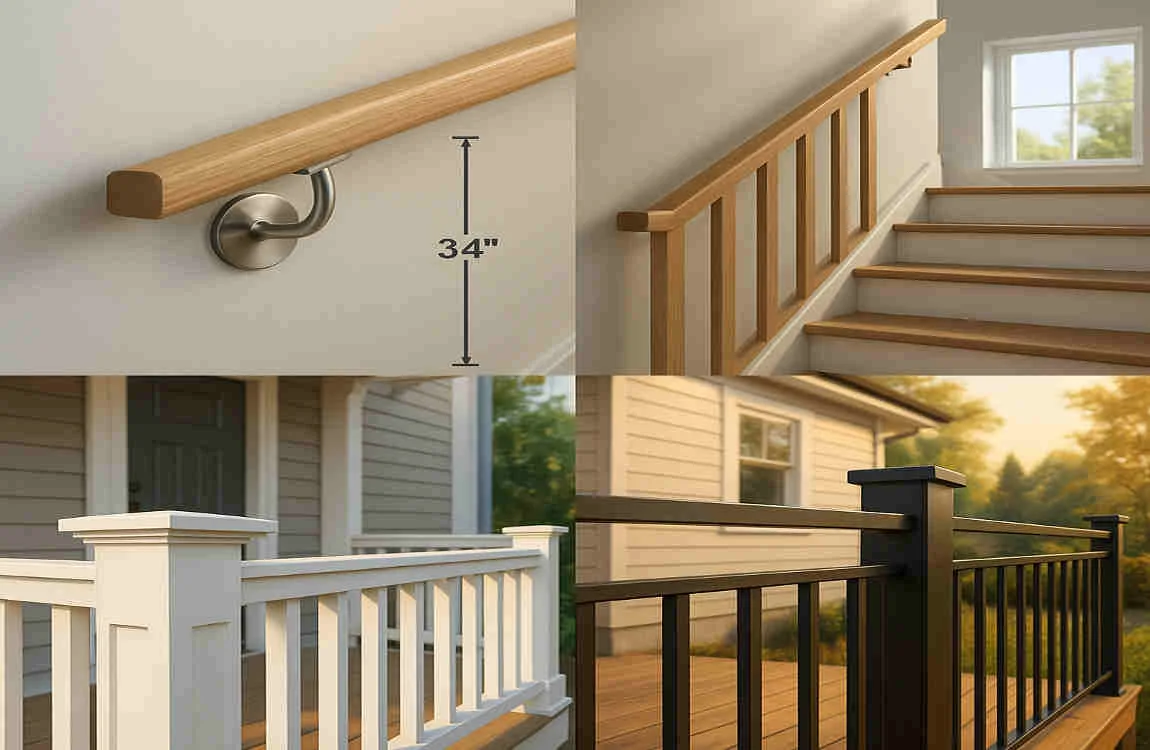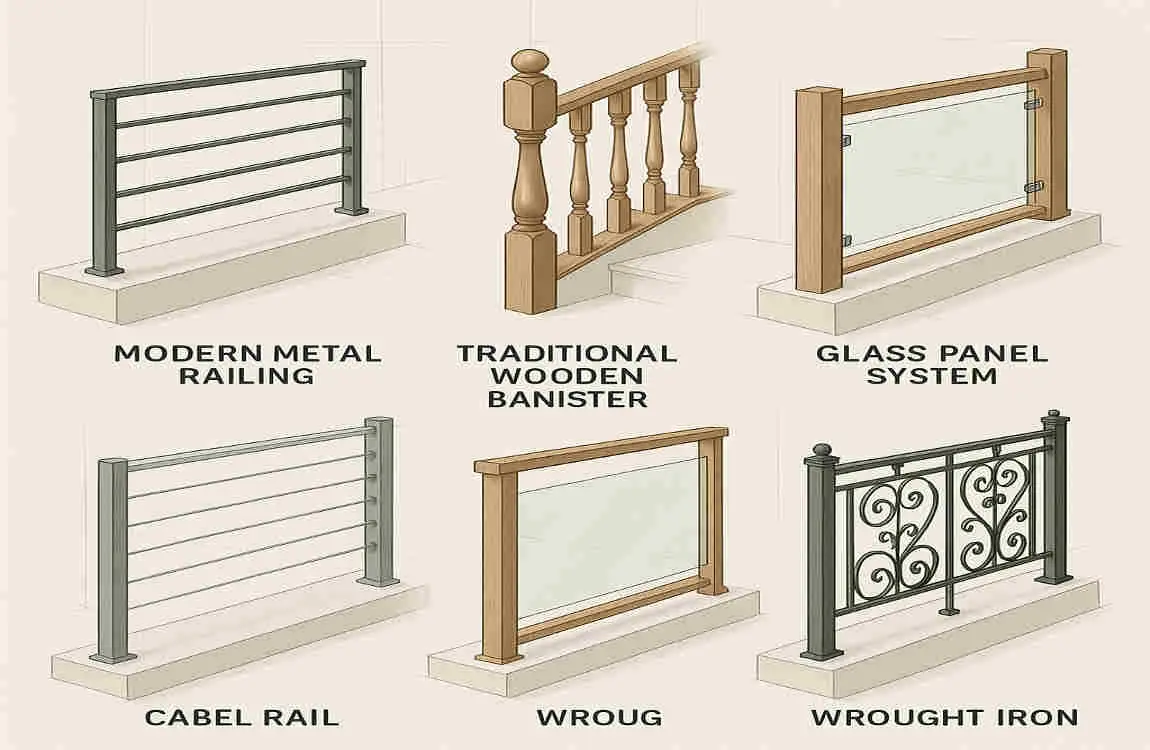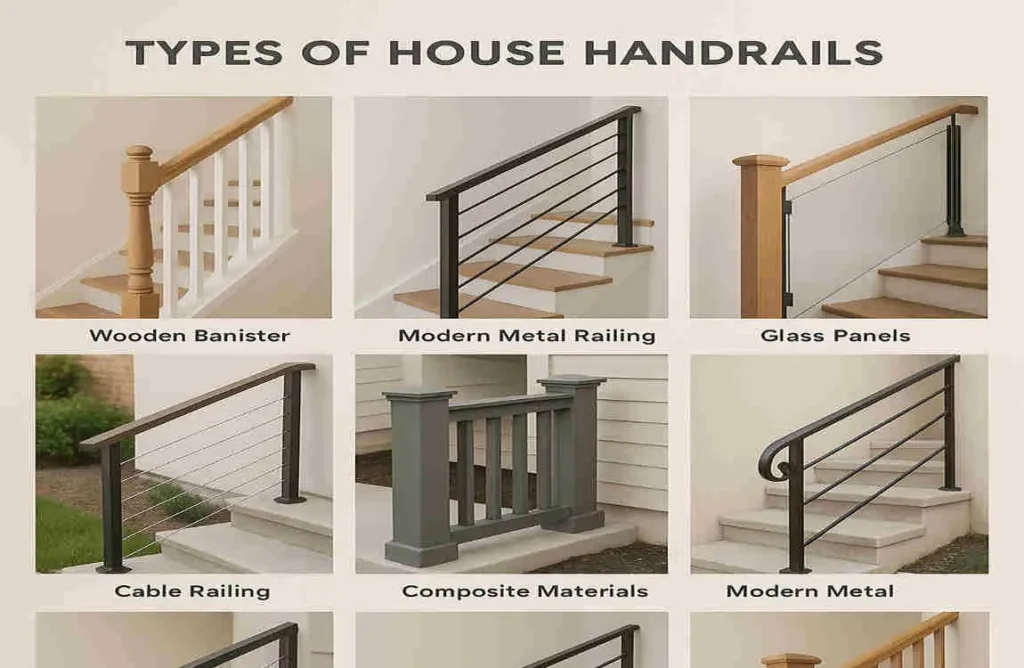Hey there, homeowner or design enthusiast! Have you ever paused on a staircase and thought about that sturdy rail you grip for support? House handrails aren’t just functional—they’re key players in keeping your home safe, stylish, and welcoming.
Imagine slipping on a wet step without a reliable handrail—scary, right? That’s why handrails matter for safety, especially for kids, seniors, or anyone with mobility needs. They also add a touch of personality to your space, blending seamlessly with your home’s vibe.
What Are House Handrails?

Let’s kick things off with the basics. What exactly is a house handrail? Simply put, it’s a supportive rail you hold onto while navigating stairs, ramps, or elevated areas in your home. Think of it as your trusty sidekick that prevents falls and offers balance.
House handrails serve a crucial role in safety. They provide that extra grip when you’re carrying groceries up the stairs or helping a child down a ramp. In fact, building codes often require them in certain spots to meet safety standards. Without them, everyday movements could turn risky.
You’ll find handrails both inside and outside the home. Indoors, they line staircases and hallways. Outdoors, they guard decks, porches, and garden paths. The key is choosing the right type based on where it’ll go and how it’ll look. For instance, an interior handrail might prioritize elegance, while an exterior one needs to withstand rain and sun.
Why bother selecting the appropriate type of house handrail? It boils down to blending function with Style. A mismatched handrail could clash with your décor or fail under heavy use. Take a moment to think about your home—do you need something sleek and modern, or warm and traditional? We’ll cover all that as we explore the different types of house handrails.
Handrails aren’t one-size-fits-all. They come in various forms to suit different needs. As we move forward, you’ll see how materials, designs, and grips play into this. Stick with me, and let’s uncover what makes each option unique.
Common Materials Used for House Handrails
Materials make all the difference when it comes to house handrail materials. They affect everything from durability to appearance. Let’s break down the most popular ones, weighing their upsides and downsides. This way, you can pick what fits your lifestyle.
You may also read (how to create stunning christmas home carol decor).
Each material brings its own charm and challenges. For example, some resist weather like champions, while others need regular TLC. As you read, consider your home’s environment—indoors or out? Budget? Style? These factors will guide your choice among the types of house handrails.
Wood
Wood is a timeless favorite for house handrails. It gives off that warm, inviting feel, like a cozy cabin hug. You can customize it easily—stain it dark for a rustic look or paint it white for a fresh vibe.
This material shines in interior settings. Picture a wooden handrail curving gracefully along your staircase, adding character to your living room. It’s versatile, working well with traditional or farmhouse styles.
But wood isn’t perfect. It requires maintenance to avoid warping or cracking, especially in humid areas. Regular polishing and sealing keep it looking sharp. If you’re handy, this might not bother you, but it’s something to think about.
Pros include affordability and easy shaping for intricate designs. On the flip side, it might not hold up outdoors without treatments. Ever thought about how wood could elevate your home’s charm? It’s a solid pick for many.
Metal
Metal handrails bring strength and a modern edge. We’re talking options like stainless steel, wrought iron, aluminum, and brass. Each type offers unique perks, making metal a go-to for durable types of house handrails.
Stainless steel, for instance, resists rust and shines in contemporary homes. Wrought iron adds ornate details, perfect for Victorian vibes. Aluminum is lightweight and weather-proof, ideal for patios. Brass? It brings a luxurious, golden glow.
Durability is metal’s big win. It stands up to heavy use and outdoor elements without flinching. Plus, you get design flexibility—bend it into curves or keep it straight and sleek.
Maintenance is low, but watch for scratches on polished surfaces. A quick wipe-down keeps it pristine. If you’re after something rugged yet stylish, metal could be your match. What appeals to you more: sleek lines or intricate patterns?
Glass
Glass handrails scream modern elegance. They create an open, airy feel, letting light flow through your space. Imagine a staircase that seems to float— that’s the magic of glass.
Safety comes first here. Always opt for tempered or laminated glass to prevent shattering. These types hold up well, even under impact.
You’ll often see glass combined with metal or wood in balustrades. It frames views on balconies or adds sophistication to indoor stairs. It’s not just pretty; it’s functional too.
Downsides? It shows fingerprints and requires frequent cleaning. But for that wow factor in minimalist designs, it’s unbeatable. Have you considered how glass could open up your home?
Composite and Other Materials
Don’t overlook composites like PVC, vinyl, or blended materials. These are engineered for low maintenance and longevity, mimicking wood or metal without the hassle.
They’re budget-friendly and resist fading, rotting, or insects—great for busy households. Use them outdoors where the weather is harsh.
While they might lack the natural feel of wood, their ease makes up for it. Think about your priorities: Do you want something that lasts with minimal effort? Composites fit right into various types of house handrails.
To help you compare, here’s a quick table on these materials:
Material Pros Cons Best For
Wood Warm, customizable, affordable Needs maintenance, not weather-resistant Interior stairs, traditional homes
Metal Durable, modern, flexible designs. Can scratch, heavier options. Outdoor decks, contemporary spaces.
Glass Open aesthetic, light-enhancing, shows dirt, higher cost, Modern interiors, balconies.
Composite Low maintenance, long-lasting, Less natural look , Budget-friendly exteriors
This table simplifies your decision-making. Now, let’s shift to how these materials shape up in structural designs.
Types of House Handrails by Structural Design

Beyond materials, the way a handrail is built matters a lot. Structural design affects installation, stability, and overall use. We’ll look at the main types of house handrails based on how they’re put together.
These designs cater to different spaces. Wall-mounted for tight spots, post-mounted for open areas—each has its place. As you explore, picture where it might fit in your home.
You may also read (what are the steps to activate my home ac).
Wall-Mounted Handrails
Wall-mounted handrails attach directly to your walls. They’re straightforward and save space, making them a top choice for narrow staircases or hallways.
Installation is simple: Brackets secure them firmly. Indoors, they provide reliable support without cluttering the floor.
They’re common on ramps too, offering a clean look. If your home has limited space, this type keeps things open and accessible. Ever installed one yourself? It’s often DIY-friendly.
Post-Mounted Handrails
Post-mounted handrails stand on vertical posts, like mini pillars. This setup is sturdy for outdoor areas, such as decks or porches.
They often integrate with guardrail systems, adding extra safety on elevated platforms. Imagine gripping one while enjoying your backyard view—secure and scenic.
For stairs leading to your front door, they’re practical. Their design allows for creative touches, like decorative posts. If you love outdoor living, this could be your go-to among handrail designs.
Guardrail-Mounted Handrails
These handrails mount onto existing guardrails, extending support where it’s needed most. Think open-sided staircases that require a barrier.
They enhance safety by providing a continuous grip along the edge. In homes with multi-level designs, they’re essential for preventing falls.
Easy to add to current setups, they blend functionality with existing structures. Have you checked your staircase for this? It might just need an upgrade.
Continuous vs. Segmental Handrails
Continuous handrails run unbroken from start to finish, offering seamless support. They’re ideal for long staircases, ensuring you never lose your grip.
Segmental ones come in pieces, with possible breaks. This allows for modular installation, handy in irregular spaces.
Choose based on your needs—uninterrupted for maximum safety, or segmented for flexibility. Both fall under essential types of house handrails, so weigh your layout.
Here’s a quick list of structural pros:
- Wall-Mounted: Space-efficient, easy install.
- Post-Mounted: Sturdy for outdoors, integrates with decks.
- Guardrail-Mounted: Enhances existing safety features.
- Continuous/Segmental: Tailored support options.
These designs ensure your handrail works as hard as it looks good. Next, let’s talk grips—because comfort counts!
Grip Styles of House Handrails
The way a handrail feels in your hand can make or break its usability. Grip styles influence comfort, especially for daily use. Let’s explore the common ones in types of house handrails.
Grips aren’t just about shape; they’re about ergonomics. A good one fits naturally, reducing strain. As we go through these, think about who in your home will use it most.
Circular Grip Handrails
Circular grips are the most popular. Their round profile is smooth and easy to wrap your hand around.
This Style offers comfort for all ages—kids can hold tight, and adults find it intuitive. It’s like shaking hands with your staircase.
Common in both homes and public spaces, it promotes safety without fancy extras. If simplicity appeals to you, this is a winner.
Pinch Grip Handrails
Pinch grips are narrower, designed for thumb-and-finger holds. They’re great for those needing extra mobility aid, like arthritis sufferers.
This profile provides a secure, precise grasp. It’s not as bulky, fitting sleek designs.
Ideal for therapeutic settings or homes with elderly residents. Have you considered accessibility in your space? This could help.
Other Grip Types
Beyond basics, you’ll find oval, rectangular, or ergonomic profiles. Ovals offer a softer hold, rectangles a modern edge.
Ergonomic ones contour to your hand for ultimate comfort. These add Style while prioritizing function.
Mix and match based on your needs—perhaps an oval for outdoors, a rectangular for indoors. They expand the types of house handrails available.
Popular Design Styles and Finishes
Now, let’s get into the fun part: aesthetics! Design styles and finishes allow you to personalize handrail designs to match your home.
From sleek modern to cozy traditional, there’s something for every taste. We’ll cover popular ones, helping you envision the perfect fit.
Modern/Sleek Metal Handrails
Modern metal handrails feature satin anodized aluminum or polished stainless steel. They scream minimalism with clean lines.
Perfect for contemporary homes, they add a futuristic touch. Imagine them in a loft apartment—edgy and elegant.
Finishes like matte or brushed keep fingerprints at bay. If your décor is all about simplicity, dive into this Style.
Traditional Wooden Handrails
Traditional wooden handrails boast carved, ornate details. They’re the heart of classic interiors, evoking timeless charm.
Options like wood veneer combine real-wood looks with added durability. Stain them to match your furniture.
For Victorian or colonial homes, they’re spot-on. Feel that warmth? It’s what makes wood enduring.
Mixed Material Designs
Why choose one material? Mixed designs blend wood with metal brackets or glass with metal frames.
This creates unique visuals, like rustic wood rails on industrial metal posts. It’s versatile for eclectic homes.
Experiment—pair brass accents with oak for luxury. These hybrids showcase creative types of house handrails.
Factors to Consider When Choosing Types of House Handrails
Choosing isn’t random; several factors play in. Let’s break them down to help you make an informed decision.
First, safety compliance. Check local building codes—they dictate height, strength, and spacing. Ignoring them could lead to fines or accidents.
Durability matters too. Indoor handrails face less wear, but outdoor ones battle weather. Pick materials that last in your climate.
Maintenance needs vary. Wood requires sealing; metal might need polishing. Think about how much upkeep you’re willing to do.
Budget is key. Composites are affordable, while custom glass costs more. Set a range and stick to it.
Style compatibility ensures harmony. Match your handrail to your home’s décor—modern with sleek lines, traditional with curves.
Finally, accessibility. Ergonomic grips help those with limited mobility. Consider your household’s needs.
Here’s a numbered list of top factors:
- Safety Codes: Ensure compliance for peace of mind.
- Durability: Match to indoor/outdoor use.
- Maintenance: Opt for low effort if busy.
- Budget: Balance cost with quality.
- Style: Align with home aesthetics.
- Accessibility: Prioritize user comfort.
Weighing these will lead you to the best type of house handrail.
Installation and Maintenance Overview
Ready to install? You have options: professional help or DIY. Pros ensure code compliance and sturdy setup—worth it for complex designs.
DIY works for simple wall-mounted types. Gather tools like drills and levels, follow guides, and take your time.
Maintenance keeps handrails safe and attractive. For wood, seal annually; metals get a wipe with mild soap.
Assess condition regularly—look for loose brackets or cracks. Replace if wobbly or damaged to avoid risks.
Outdoor handrails need extra care against rust or fading. A quick seasonal check goes a long way.
Curious about handrail installation? Consult tutorials or experts. Your safety depends on it.
You may also read (what are the best tips for house renovation success).
